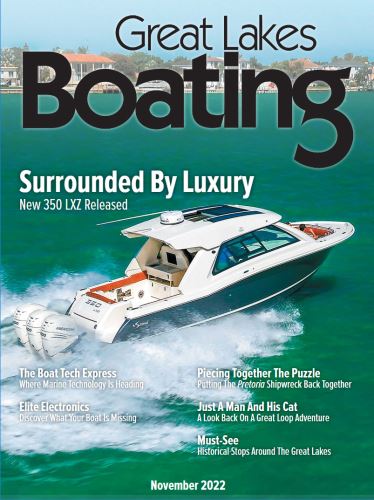
Slightly Off Course
These five wrecks go unnoticed by legend hunters, who jump to the disappearance of Northwest Airlines Flight 2501 as the keystone of The Michigan Triangle. The four-engine DC-4 plane taking its regular course from New York to Minneapolis and onto Seattle, was last heard from near South Haven, Mich. Its disappearance with 58 people marked the worst aviation disaster in the country at the time. Over the next seven days, the Coast Guard and the Navy conducted search operations and recovered approximately 7000 pounds of floating debris, including broken pieces of fuselage, passenger luggage, small pieces human remains. While teams of experts have discovered unmarked graves of unidentified victims, the actual wreckage remains unfound.
The New York Times reported the disappearance June 25, 1950: “A Northwest Airlines DC-4 airplane with 58 persons aboard, last reported over Lake Michigan early today, was still missing tonight after hundreds of planes and boats had worked to trace the craft or any survivors. If all aboard are lost, the crash will be the most disastrous in the history of American commercial aviation. In his last report, Captain Robert Lind requested permission to descend from 3,500 to 2,500 feet because of a severe electrical storm which was lashing the lake with high velocity winds. Permission to descend was denied by the Civil Aeronautic Authority because there was too much traffic at the lower altitude.”
The Other Side
Since 1950, and likely aided by the advent of mass media, reports of everything from unexplained drownings and mysterious shipwrecks, to paranormal activity has been reported within the bounds of The Michigan Triangle. No matter your personal inclination, there are always two sides to the story.
Valerie van Heest is a maritime historian, author, museum exhibit designer who serves as the director of the Michigan Shipwreck Research Association, and whose team uses a 24-foot Bayliner to plumb the depths of the Great Lakes for such shipwrecks. She’s not the Lara Croft-style tomb raider you might expect, though. Valerie’s feet are planted firmly in reality as she’s quick to let everyone know.
“As far as this Michigan Triangle, it’s giving real history a bad name,” Valerie says. “There are a lot of mysteries on the Lakes, there are ships that went missing with all hands that have never been found. The truth behind that is: it’s a dangerous lake. There is no triangle! You could call it the Michigan Banana, really, because that’s the shape of the entire Lake Michigan. In fact, you could take any body of water and draw any shape on top of it, and there are going to be ship accidents that happened in that area.”
Valerie became fascinated with ships gone missing in Lake Michigan as a scuba diver growing up along the shores of Lake Michigan north of Chicago. She has written six books detailing factually-sound histories of the Great Lakes, including the award-winning Fatal Crossing, the Mysterious Disappearance of NWA Flight 2501 and the Quest for Answers. She and her team have lead the charge in discovering two unmarked graves of Flight 2501 victims and continue searching the depths of Lake Michigan for the downed plane. When asked which theory she does support about “strange” disappearances on Lake Michigan, she simply states the facts that often get trampled on our way to an entertaining story.
“It’s a dangerous body of water. For the last 300 years of commercial shipping and last century of commercial aviation, a lot of accidents have occurred for a variety of different reasons,” explains Valerie. “Fifty percent of those reasons are for storm – and in fact it was a storm that caused the crash of Northwest Flight 2501 – but a number of ships have gone down due to fire. There’s mechanical malfunction. There’s ice. There’s collision. There’s human error. Together, these factors have contributed to some 1,500-2,000 losses on Lake Michigan alone. Interestingly, 25 percent of shipping accidents occur very close to shore, within about a quarter-mile. Shore is not always a boater’s salvation in a storm.”

